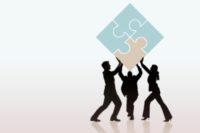 ISHN conducted an exclusive interview with Scott Geller, a distinguished professor at Virginia Tech and a senior partner of Safety Performance Solutions. Scott presented a talk at ASSE Safety 2014 on “The Psychology of Safety: Paradigm Shifts for Achieving an Injury-Free Culture.”
ISHN conducted an exclusive interview with Scott Geller, a distinguished professor at Virginia Tech and a senior partner of Safety Performance Solutions. Scott presented a talk at ASSE Safety 2014 on “The Psychology of Safety: Paradigm Shifts for Achieving an Injury-Free Culture.”
ISHN: Why are profound paradigm shifts difficult for many safety professionals to achieve?
Scott Geller: Change is difficult, especially when the current perspective is traditional, the way it’s always been done. These shifts ask people to move to something new. We want things to be consistent. We want to be able to predict. Wow, don’t ask me to change. People don’t see it as an evolution. It’s going from behavior-based safety to humanistic behavioral science.
What’s in it for them if they change, if they make the shift? It’s dealing more effectively with the human dynamics of safety if they really want to reach an injury-free culture. I’m saying this from 50 years of psychology teaching and research, these paradigm shifts(see the end of this article for the list) are life lessons, they reflect my history of reading, learning, researching the psychology of safety.
Is it possible for one safety manager in a company to optimize by himself leadership, followership, trust, behavior-based coaching, systems thinking, interdependency and authentic engagement, the things you mention in your talk? Seems like a lot to take on.
I think any one person can learn and understand and shift the way they think, talk and act. They can be inspired to read my proceedings paper. These shifts are not that dramatic. I think we start to change our culture by changing our language, by conversations.
Start using the term, “accident analysis” instead of “investigation.” It takes conversations to do this.
Ask the employees: where and when will the next injury occur? This is inclusion. How do we include, engage the workforce in injury prevention? Supervisors are too much into production and top down thinking; they must think of safety in a different way.
The foundation is humanistic behaviorism. It’s using the principles of humanism to make behaviorism more effective. It’s about Maslow’s hierarchy of needs, about reaching self-transcendence.
Also, this is behavioral science, it is not common sense. I still hear too many people say safety is just common sense. The foundation for shifting safety paradigms is all about being proactive. How do we shift proactively to a more self-focused living? How do I improve myself through self-motivation? We want to move from failure avoidance to success seeking. The paradigm of coaching shifts -- how can I improve the behavior of others, bring out the best in others? The leadership paradigm is how can I improve the organization as a whole?
I suggest people Goggle “Geller on TEdX talk.” It’s 15 minutes on self-motivation. Self-motivation is the key to safety, man. How do we help people become self-directed?
How can these key elements be practically optimized given limited safety budgets and staffs?
I’m asking for a shift in perspective, in communication, in how we view the process, including BBS. This doesn’t take any money. It’s really education. We’re talking about moving from the safety cop to bottom- up involvement.
Just change the nature of your conversation. Ask more questions. Inviting people into the conversation doesn’t cost money. You will learn that people have something to say. They are the experts. This might take time, this shift in our language we use for safety.
Should the typical ASSE member attempt to optimize all of these key essentials – engagement, building trust, coaching behaviors, creating interdependency, etc – at the same time, or do it piecemeal, tackling and implementing say systems thinking first, then on to the next one?
First, different situations call for different paradigm shifts. Say you’re doing a so-called accident investigation. Hmm, watch your language, call it an analysis. Don’t look for one root cause, but causes.
Give some time to the other person to get their point of view. How about we become more empathetic, listen with empathy. The cost is not money but time. We’re going from efficient conversation (email, voice mail) to a one-to-one sit-down discussion.
This is all easier said than done. Learn about it, it is not enough to understand, you’ve got to believe, you’ve got to read my paper, or purchase a book on the psychology of safety. I think it’s continuous learning, continuous improvement.
We can each reach an approximation of these shifts --show people the natural consequences of what they’re doing. Ask where next injury will happen, and then do something about it. That’s the natural consequence of the request for their suggestion. When you do something about their suggestion, they say, “Hey, they do care.” You are demonstrating actively caring.
Do you begin by tackling leadership, or one of the other elements? How long will the process take to achieve improvements in all the areas you describe – trust, interdependence, followership?
I think everyone can be a leader. There is a time to be a leader, and a time to be a follower. Leaders understand to be a humanistic behaviorist, I’ve got to let someone else take the lead. It’s knowing when to take charge, when to step back. You have to discriminate when to take charge and when to sit back and listen. Sometimes the leader listens to the students, sometimes things get out of hand, and leader must step back in. it all depends on the situation and self-monitoring skills and discrimination.
How do you measure whether or not you have successfully shifted paradigms?
The first thing is, as Deming told us, you can’t measure everything. We’re talking about thinking, conversations, strategies. You can measure self-esteem, optimism. These shifts are based on research and when people read the research, they see that they are the right thing to do.
A simple measurement tool is to look at the reaction of the people you’re talking to. Their reaction to the fix you’ve made based on their suggestions. The extent to which I can operationalize the paradigm shift into a process, into a behavior, that’s how you can measure the shift. You have to move from one root cause to contributing factors.
I want more people involved, talking, more involved in injury analysis than they were before.
A perception survey can get at all this by asking questions related to paradigm shifts. Or you can have an informal discussion, a straw poll, a show of hands. These paradigm shifts could suggest questions on a perception survey. Are some of these shifts reflected in the survey responses? If not, you have to add some questions. Do people truly believe in the changes? You need to believe so you’re willing to teach. Then when you teach you really start to believe, you start to operationalize concepts, implement things, how we communication.
So we move from understanding to believing to teaching to more believing. This leads to a change in one’s self-perception. It’s a process. Hopefully I can plant some seeds. Read to the20-page paper and the handout so you can teach others.
Check out my TEDx talk on self-motivation. Key concepts for the psychology of safety are addressed. The link is: http://www.youtube.com/watch?v=7sxpKhIbr0E
Scott’s paradigm shifts:
1 - From Managing Behavior to Actively Caring for People (AC4P).
2 - From Behaviorism or Humanism to Humanistic Behaviorism,
3 - From Common Sense to Behavioral and Psychological Science.
4 - From Reactive to Proactive Intervention.
5 - From Complacent Competence to Continuous Improvement.
6 - From Other-Directed Accountability to Self-Directed Responsibility.
7 - From Extrinsic Consequences to Intrinsic Consequences and Self-Motivation.
8 - From Failure Avoiding to Success Seeking.
9 - From Habitual Behavior to Mindful Fluency.
10 - From Self-Confidence to Courage, Humility, and Integrity.
11 - From Efficient Communication to Effective Conversations.
12 - From Person-Based Feedback to Behavior-Based Feedback.
13 - From Directive Instruction to Nondirective Empathic Coaching.
14 - From Finding Fault to Finding Facts and Asking “What can I do?
15 - From the “Golden Rule” to the “Platinum Rule” (treating others the way they want to be treated).
16 - From Fixed Mindsets (Traits) to Growth Mindsets (States).
17 - From Labeling Achievers to Celebrating Effort.
18 - From Marketed Programs to Customized Processes.
19 - From Training to Education/Training.
20 - From Power Imbalance to Feeling Empowered.
21 - From Root-Cause-and-Effect to Systems Thinking.
22 - From Investigating “Who?” to Analyzing “How?”
23 - From Suspiciousness to Interpersonal Trust.
24 - From Pushing Priorities to Supporting Values.
25 - From Independence to Interdependence.




